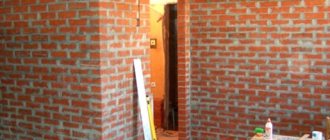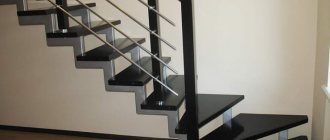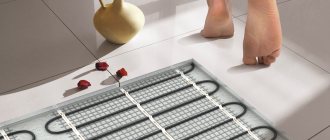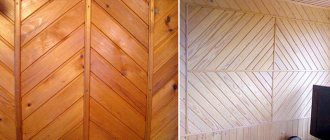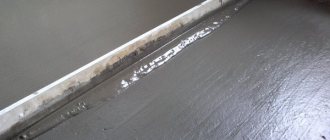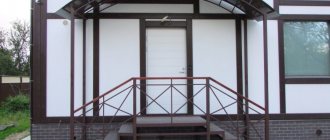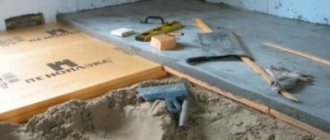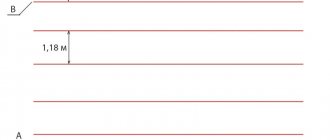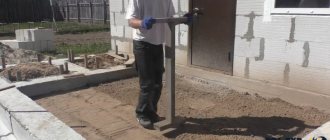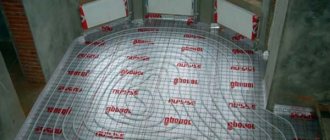Today, a warm water floor is a popular heating system, which has a simple installation technology, has an acceptable cost and affordable operating costs. In addition, unlike electrical systems that emit electromagnetic waves, it is completely safe for human health.
It is important that the installation technology is not complicated, so installing a water heated floor with your own hands will not be difficult for almost every home craftsman. And an important advantage of self-installation will be a reduction in overall costs, which will undoubtedly affect the total cost of operation and installation of this heating system.
We also suggest you learn how to make a heated floor in a bathroom using a heated towel rail or in an apartment using central heating.
Advantages and disadvantages of water heated floors
The main advantage of hydraulic floors is ensuring horizontal, uniform heating of the room. In this case, heat spreads vertically, which creates a healthy microclimate, unlike radiator devices. Installation of such a system is especially recommended for rooms with high ceilings.
If we consider water structures from an aesthetic point of view, they also benefit because they are not visible and do not take up useful space. In addition, as mentioned above, they are more economical to use.
The efficiency of water floors depends on good thermal insulation, because an increased level of heat loss reduces heat transfer. But installing such a system in a bathroom or toilet has its drawbacks - the possibility of overheating the surface, since more often the heating element is connected to a heated towel rail.
In addition, such floors have a negative impact on the height of the room, because the “pie” implies the presence of a thick layer of concrete screed. Also, pouring concrete significantly makes the structure heavier, so it is necessary to carry out work to strengthen the floors.
Do-it-yourself installation of heated floors under laminate: video instructions, consumer reviews
For those who are faced with installing a heated floor for the first time, there are a lot of educational video instructions on the Internet. Here are the secrets of installing various types of heating: film, cable, water and others. Once you decide on the type of heated floor, choose a suitable plot with instructions.
Note! The information in the training videos is for informational purposes only and is in addition to the mandatory instructions for installing a particular underfloor heating system.
Videos of installing heated floors under laminate contain a lot of useful information about the nuances and principles of installation of both heating systems and installation of laminate flooring. In addition, by looking through them you can learn about the features of connecting wires to the infrared floor system, methods of insulation, start-up and testing of the system.
Warm floors are the key to coziness and comfort in the home.
Watching video tutorials will help you choose the best heating option for the floor covering of your room. In addition, useful recommendations will facilitate the correct selection of the thickness of the screed layer (if provided), the required heat-reflecting material, and the substrate used.
It would be a good idea to ask for reviews before choosing the system you need. Warm floors under laminate cause conflicting opinions among many. Only after thoroughly studying them and weighing all the pros and cons, you can make a choice in favor of one or another type of underfloor heating specifically for your room.
Infrared film has received many positive reviews. Warm floors under laminate with such heating, judging by the responses, are easy to install, do not reduce the height of ceilings, function properly and can be used for rooms with a large load on the finishing coating (offices, gyms). In addition, such a system can be installed when dismantling the old floor in Khrushchev-era buildings.
3D visualization of a heated floor system under laminate.
Reviews of the heating cable indicate that this type of heated floor is used both in new buildings and in apartments of old housing stock. Equipping the system with a thermostat allows you to set the desired temperature and, if necessary, save energy consumption by reducing power.
When installing a heated floor, it is necessary to take a responsible approach to the use of this or that floor covering. When choosing a material, it is necessary to check with consultants how compatible this coating is with a heated floor system, and what is the maximum temperature that the material can withstand.
Water heated floor installation
The heated water floor has a multi-layer complex structure, each layer has its own function. Consists of: base, hydro and thermal layer, reinforcing product, heating element and concrete screed.
A substrate is placed on the screed on which the floor covering is mounted; it must have a special symbol indicating the possibility of laying it on warm systems.
Important! The junction of the walls and the screed, as well as the boundaries of the water circuit, should be laid with damper tape, this will help compensate for the expansion of concrete with temperature changes.
More often, independent installation of this heating structure is carried out using the “wet” method, that is, by pouring a cement-concrete screed. But “dry” installation is possible; it is used in houses with wooden floors.
Electric
The optimal solution in a city apartment was an electric heated floor. Its advantages include:
- ease of installation;
- using the capabilities of electronics, modern thermostats make home climate control truly convenient;
- takes up less usable space due to the more compact size of the heating elements.
If you carefully read the instructions for laying heated floor elements, even people who are far from electricians will not have any difficulties. Installation is very clear and includes the following steps:
- When drawing up a cable laying diagram, you need to take into account the location of heavy objects in the room, and avoid these places.
- Installation of the control unit and thermostats, connecting them to grounding and power cables.
- Surface preparation, mandatory waterproofing.
- Laying a circuit of heat cables starting from the thermostat, without bending it excessively. For convenience, you can make markings on the base according to a pre-drawn diagram.
- Covering with reinforcing mesh and fixing heating elements on it.
- Connection to the thermostat; the connection points must be covered with a corrugated pipe.
- Testing for performance in different modes.
Screed and final coating. It is worth being careful when choosing a material; traditional parquet, laminate or linoleum can be deformed by temperature changes if they are not specifically designed for heated floors.
What kind of room should there be, preparation and leveling of the floor
Due to the fact that the structure is heavy, with a long length of pipes and connecting units, the installation has its own technological features.
As a result, it is necessary to lay each layer strictly according to the instructions. But first, we will look at the features of preparing the premises.
Watch the video
WARM FLOOR in 1 day! DIY water heated floor part 1
Premises requirements
Water-heated floors are recommended for construction in private buildings - find out how to install them yourself on a concrete floor. In multi-storey buildings, in addition to the heavy load on the floors, there is a risk of flooding of the apartment from below.
In addition, the coolant circuit is connected to the general heating system, but it is most often not intended for this purpose. This can lead to cold risers in your or a neighboring apartment. This is due to the reluctance of the relevant authorities to issue permits for the installation of this system in multi-storey buildings.
For your information! Today, two systems are often installed in new buildings: one for standard heating, and the other for warm floors.
The ideal solution is to make a water-heated floor yourself, even at the time of building the house. When installing the structure in a finished house, you should consider:
- the height of the ceilings, since such a structure leads to a significant decrease in them;
- size of doorways - their required height is not less than 210 cm;
- foundation strength.
In addition, the heat loss rate should not exceed 100 W/m2.
Base requirements
When installing a water floor correctly, a prerequisite is the presence of a smooth and clean rough surface. If the property is old, you need to dismantle the old floor screed and level the base.
The process is complex and time-consuming, but it is necessary. After which, the base is thoroughly cleaned of debris and dust.
For a water floor to work well, you need a horizontal base without differences; deviations of no more than 10 mm are permissible. If cracks or flaws are found, they must be repaired.
If you are the owner of a new home with panel ceilings, then the heating elements can be installed directly on them.
Stages of work
Installing a heated floor in an apartment or private house is a set of measures that are carried out in a strict order:
- Design - calculation of the required heat transfer, laying pitch and length of pipes, breakdown into contours. Depending on the type of base (floor), the composition of the heated floor “pie” is selected.
- Selection of components and building materials - insulation, pipes, manifold with mixing unit and other auxiliary elements.
- Preparing the base.
- Installation work - laying out insulation and pipelines, installing and connecting the distribution comb.
- Filling the system with coolant, hydraulic testing - pressure testing.
- Pouring a monolithic screed using cement-sand mortar, initial start-up and warm-up.
Recommendation. Install the TP during the construction of the building, immediately after the construction of partitions between rooms. This will allow you to provide the required height of the thresholds and freely fit the “pie” under the floor covering. If doorways with low thresholds have already been formed in residential premises, try to get out of the situation using the suggested methods.
Let's move on to a detailed consideration of each stage of arranging heated floors.
How to select and calculate pipes
Before you begin independent work on the construction of a hydrofloor, you should choose the right type of pipes and calculate the optimal diameter size.
Video
Pipes for heated floors. Recommendations from experts // FORUMHOUSE
Types of pipes
Today, a large number of types of pipes are produced for installation in water-heated floors; they are made of various materials.
Professionals advise that when installing yourself, give preference to cross-linked polyethylene pipes such as PEX or PERT. The ideal option is PE-Xa, which has the highest cross-link density (85%).
This makes it possible to use axial fittings that have a sliding end; they can be safely mounted in a concrete structure. In addition, if such pipes are broken, it is not difficult to return them to their original shape using a hair dryer by heating the broken area.
Read the article: there are situations when it is necessary to connect pipes together in a screed, a pipeline has been pierced or you need to extend it - find out how to do this.
PERT circuits do not have a memory property, so it can only be used with push-in fittings, which are not recommended to be hidden in a screed. But if the system is assembled from solid pipes, then the connecting nodes will only be on the manifold, and this type of pipe is quite suitable.
When installing water systems, experts recommend using the PE-Xa or PERT model with a polyvinylethylene layer, which can be on the outside or inside. It is better to install pipes with an inner layer of EVOH.
For your information! By choosing a PE-Xa circuit, you can test it yourself. A section of pipe needs to be folded, and then this section must be heated using a hair dryer. If the product is of high quality, it will return to its original form.
In addition, metal-plastic pipes are often installed - the price is not expensive and they are not difficult to install. There are copper pipe products that are more expensive and require protection from alkaline exposure when pouring concrete mortar.
Another type of pipe recommended for heated floors is composite. They consist of two layers of cross-linked polyethylene with foil between them. The presence of inhomogeneous material that has a different expansion coefficient when heated can cause delamination of the circuit.
When choosing a model, you must consider:
- brand (Rehau, Tece, KAN, Uponor) is a guarantee of quality;
- labeling;
- certificate of conformity for products;
- take into account the coefficient of thermal expansion of pipes;
- cost of components required for installation.
Pipe size calculation
For water floors, three main pipe sizes are available: 16*2, 17*2 and 20*2 mm. The most popular sizes for installation are 16*2 and 20*2.
Before purchasing a heating circuit, you should calculate the size. If you are not sure that you can do it correctly yourself, it is better to entrust it to professionals. To do this, you need to decide:
- with a diagram of the location of the water heated floor;
- with areas of the floor where furniture will be placed and plumbing installed (pipes are not installed under furniture).
A product with a diameter of 16 mm should have a contour no more than 100 meters long, with 20 mm - 120 m. That is, each should occupy a maximum of 15 square meters. m, otherwise the pressure in the system will be insufficient.
If the room is large, it is divided into several circuits. They must be the same size, the difference is allowed within 15 meters. If there is good thermal insulation, the standard laying step is 15 cm, it is permissible to reduce it to 10 cm.
During the laying step:
- 15 cm - you will need 6.7 meters of heating element per 1 sq. m;
- 10 cm - 10 m.
In addition, when calculating the size of a water floor, heat loss, system power, material of pipes, ceilings and flooring are taken into account.
The standard formula for determining the size of the circuit is the heated area in sq. m. need to be divided by the laying step in meters. To this indicator add the size of the curls and the distance to the collector.
Is it possible to put heated floors under laminate?
When deciding which heated floor is best for laminate, it should be taken into account that this material is vulnerable to moisture and sudden temperature changes. Then the question arises: is it possible to make heated floors under laminate? After all, not all laminate manufacturers produce panels that can be combined with heating elements. Having understood the basic parameters of laminated coatings and the operating conditions of heated floors, you can determine the heating system that is most suitable for laying this material.
Before buying laminate for heated floors, pay attention to the instructions for the material, which must indicate the possibility of such use. Markings with the recommended temperature limit can be seen on the packaging of the laminate. If you find it difficult to determine exactly where the information you need is listed, contact a consultant for help.
Warm laminate floors today are no longer something out of the ordinary, but quite commonplace.
Many modern manufacturers produce laminated panels that are adapted to install underfloor heating. In this case, the manufacturer indicates which type of underfloor heating is recommended for this product. Installing a heated floor under a laminate that is not designed for the use of this or that heating can lead to both failure of the system and damage to the laminated coating itself.
An innovation in the flooring market is laminate with built-in heating elements, thanks to which you can install a new beautiful floor immediately with heating. To install such a laminated coating, you must additionally purchase a transformer and accessories.
Laying laminate lamellas with a built-in heating system greatly simplifies the process of installing a heated floor. The covering is laid using special aluminum locks that securely and easily fix the boards together. In addition, the locks guarantee the safety of connections during operation. This flooring can be laid on any surface, including balconies and loggias.
The most modern and popular electric heating system today is underfloor heating.
Selecting a circuit laying scheme and its installation
When choosing an installation scheme and calculating the pitch, you should take into account that the liquid cools down as it passes through the circuit, so installation must be done from the outer walls. This will help protect the heated room from cold air entering.
The level of heating of the room depends on the layout of the heating element:
- “snake” is the easiest way for self-installation, the degree of heating decreases gradually;
- “snail” - the process is more complicated, but the room with internal walls is heated evenly.
When installing a warm water structure, the calculation data and installation diagram are taken into account. The standard laying step is 15 cm, and contours longer than 100 meters must be divided into several. In addition, each room should have a separate circuit.
For your information! Couplings or fittings are installed only when eliminating breaks or carrying out repair work on heated floors.
In addition, when preparing the calculation and diagram, the hydraulic resistance is taken into account; it depends on the number of turns; the more there are, the higher the resistance. Each circuit connected to the manifold must have the same given value.
Infrared heated floor under laminate
You can buy heated floors for laminate by ordering products on the websites of manufacturing companies and on the Internet. Systems of all brands are available for sale. The price of infrared heated floors for laminate depends on the manufacturer, the size of the film coating and the configuration. Heated floors presented in Russia, certified by the IR Radiation Association, are popular.
Film flooring is a modern version of an electric floor.
The electric floor developed by the Korean company Heat Plus has proven itself well. This manufacturer specializes in the production of film infrared floors and is constantly improving and updating its equipment. Over the past few years, production has been carried out on unique machines. RexVa floor heating systems, presented, are focused on the production of individual orders of film flooring, taking into account an acceptable price for the consumer.
The table shows the approximate prices at which you can buy infrared heated floors for laminate:
| Company | Series | Cost of the set, rub. | |
| from | before | ||
| CALEO | Line | 1690 | 7050 |
| Grid | 1250 | 27800 | |
| Gold | 1480 | 29500 | |
| Platinum | 1750 | 30500 | |
| Q-TERM | 450 | 11900 | |
| Heat Plus | 650 | 17900 | |
| NanoThermal | 990 | 19900 | |
The minimum price of heated floors for laminate per m2 produced by RexVa and Heat Plus companies is from 850 rubles, Caleo infrared floors will cost a little more - from 1,500 rubles per 1 m2.
On a note! When purchasing products from one manufacturer or another, request a certificate for infrared heated floors for laminate flooring. Consumer reviews will also give an idea of the feasibility of using the chosen option.
Selecting a collector-mixing unit
The choice of collector (see types, principles of operation and installation of the collector, connection diagram and configuration) is directly related to the number of circuits that are planned to be installed. The device must have as many outputs as the water floor structure will have.
The device allows you to adjust and supply heated coolant into the system, and discharge it back to the device after working out.
The simplest model of the corrector has only a shut-off valve, and it cannot be used to adjust the operation of the structure. More expensive devices are equipped with valves for adjustment; they make it possible to independently set the level of intensity of water flows, separately for each circuit.
In addition, a mandatory attribute of any manifold is an air vent valve and a drain valve for emergency situations. In order for the device to work normally, you only need to adjust all the valves once, according to the required parameters.
It is worth noting that inexpensive collector models are often installed. But if you do not need to save money, then it is better to buy a model with servo drives and mixing units. This device allows you to automatically regulate the degree of heating of the water supplied to the water floor.
The collector is installed directly in the heated room or in a room nearby. To install the device, a special cabinet is made, its standard size is 50 by 50, and its depth is 12 - 15 cm. It is placed above the surface of a warm water floor. It is not uncommon that the manifold cabinet does not spoil the interior of the room, it is recessed into the wall.
Video
Manifold for heated floors. Three ways to configure flow meters.
Insulation and connection of electric heated floors under laminate
The next step is to connect the contact terminals. They are installed on a copper strip so that one side is inside and the other outside the thermal film. After this, the terminals are clamped tightly with pliers. All contact connections and cut points of the copper bus must be insulated with the bitumen insulation included in the kit, using two pieces per area to be treated.
Thermostat for heated floors.
Next, install the thermostat. The temperature sensor is located on the black strip of the thermal film. To prevent it from protruding on the surface of the film, a cutout is made under it in the reflective material. The same cutouts are made for wires and contact clamps. This will make the laminated coating as smooth as possible. The places where the wires pass from above are sealed with tape.
The thermostat panel is installed in a previously prepared place, and the wires are connected to it according to the attached diagram. The thermostat is connected to the electrical network through a separate machine. Next, the system is tested, setting the temperature to no higher than 30°C. After making sure that the heated floors are functioning, you can begin laying the laminate.
The sequence of laying a heated floor is clearly demonstrated in numerous videos of installing an infrared heated floor under a laminate.
Installation of a warm water floor on a concrete screed
Installing a warm water structure with a concrete screed yourself is a labor-intensive and time-consuming process, since it takes about a month for the concrete to harden.
The construction of the structure consists of several step-by-step actions, which we will discuss below.
WARM FLOOR IN A READY SCREED WITH YOUR OWN HANDS. SIMPLE OR EASY?
Layers of water heated floor
Before installing the floor with your own hands, you should familiarize yourself with both the installation technology and the layers of the floor “pie” that will be laid. Each layer is laid strictly in a certain sequence. The thickness of the structure is from 8 to 14 cm, and the load on the floors is about 300 kg/sq.m.
Let's look at what a heated floor consists of and its design:
- foundation - reliable and durable;
- vapor barrier layer - a polyethylene film with a thickness of at least 0.1 mm is used;
- insulation - extruded polystyrene foam is used;
- reinforcement - it gives strength to the structure;
- heating elements - pipes laid according to the diagram;
- concrete screed with plasticizer - its thickness is from 3 to 5 cm.
If the heated floor is placed on the ground, then the “pie” is as follows:
- bulk soil - 15 cm;
- crushed stone fractions - 10 cm;
- sand - 5 cm;
- rough screed;
- waterproofing material;
- damper tape;
- insulation - 5 cm;
- reinforcing mesh;
- heating elements;
- cement-concrete screed.
After the concrete has hardened, the flooring is installed on the surface and the finishing coating is laid.
Waterproofing
The waterproofing layer, as mentioned above, must be laid on a prepared subfloor; it must be smooth and clean.
An ordinary polyethylene film is used as a waterproofing material; it should be laid overlapping, one strip on top of the other and on the walls (20 mm). For tightness, the joints must be glued with tape.
Damper tape
The damper tape is designed to compensate for the expansion of the concrete screed when the system heats up. It protects the surface from cracking. The standard thickness of the mounting tape is 5 - 8 mm, and the height is from 10 to 15 cm.
For your information! When concrete is heated to 40°C, it expands at a rate of 0.5 mm per 1 meter.
It is glued along the perimeter of the heated room, at the junction of the walls and floor. The tape should be higher than the screed, and its excess, upon completion of installation, is cut off with a knife. In addition, if there are several contours, their boundaries are lined with it.
Laying insulation
When installing a warm floor with your own hands, it is important to choose the right type of insulation. The efficiency of the device depends on it, because it does not allow waste of heat.
There are many types of material for thermal insulation, but experts recommend two:
- Extruded polystyrene foam - low thermal conductivity and high mechanical strength. EPS is not exposed to moisture as it does not absorb it. In addition, it has an acceptable cost. This type of gasket is produced in slabs measuring 50 by 1000 mm or 600 by 1250 mm, and with a thickness of 20, 30, 50, 80 and 100 mm. The product is equipped with snap-on grooves, which allows for a strong connection.
Expanded polystyrene sheets are equipped with a foil layer, which leads to higher prices for products. But there is no significant benefit from it, since the reflective property does not work in an opaque environment. In addition, the cement mixture is alkaline and will corrode the foil.
- Profile polystyrene mats are highly plastic, equipped with special bosses, and pipes are laid between them. Also, the bosses serve as a retainer for the heating elements. In them, the contour is attached in increments of 50 mm. Using a mat greatly simplifies the installation process, but the cost is higher than polystyrene foam insulation. The thickness of the slabs is from 1 to 3 mm, and the sizes are 500 by 1000 or 600 by 1200 mm.
When installing a water-heated floor yourself, you need to choose the right insulation thickness. To do this, you must adhere to the following rules:
- when laying heating floors on the ground, the minimum thickness of the insulation should be 100 mm; it is recommended to install two layers of 50 mm each, located perpendicular to each other;
- when installing on the ground floor, 50 mm is sufficient;
- when carrying out thermal insulation in rooms above warm rooms - 30 mm.
Sheets of insulation are placed around the entire perimeter of the area and fixed to the base. If EPS boards are used, they are fastened with disc-shaped dowels at the joints and in the center.
Reinforcement
The need for reinforcement during self-installation of warm water floors is that the mesh gives strength to the structure, ensures uniform heat distribution and heating elements are fixed to it.
The standard diameter of reinforcing mesh rods ranges from 4 to 5 cm, and the cells come in different sizes; they must be selected depending on the laying step.
Experts advise laying two reinforcing layers. The first is on the insulation, and the second is on top of the heating elements (pipes). The grids are connected to each other using wire.
Advice! If you do not want to lay two layers of reinforcement, then before installing the mesh on the insulation, you should make supports under it so that when pouring the solution, it can flow under the reinforcement.
Laying and fastening of pipes
Laying heating elements is the most critical stage when installing warm water floors. In addition, it is good to have a device for unwinding pipes in coils, since removing them with rings is prohibited; a lot of tension is created, which interferes with installation.
Important! It is unacceptable to remove the contour from a stationary bay; it must be rotated. You can go on a spree yourself, but it’s easier to do it with the help of a device.
If the insulation boards have markings, the installation process will be greatly simplified. If these are not available, they should be applied independently. It is necessary to make marks on the plates with a marker in accordance with the step of laying the heating element. Then, using a painting thread, mark a line and draw a route for the contours.
When installing water pipes yourself, you need to remember that you need to retreat 15 - 20 cm from the walls. Ideally, each contour will be single, without seams, and with a maximum size of 100 mm. Installation should be done according to the diagram, in accordance with the calculation. The permissible step near the walls is 10 cm, closer to the center - 15 cm.
The installation of the circuit must be done from the most remote areas from the collector. In addition, the transit sections of the product should be insulated with foamed polyethylene, this will save energy and prevent heat from being lost along the way. In this case, both ends should go to the place where the manifold cabinet will be installed.
To fix the circuit, fastening profiles are used, which must be screwed to the floor with dowels. After which, the pipes are pressed against the reinforcing mesh and secured with plastic fasteners. The pipe should not be pressed too hard; the loop should fit freely against it.
You need to bend the contour carefully, especially if it is made of polyethylene, because this material is subject to deformation. Polypropylene pipes are difficult to bend; they spring. Therefore, when installing heated floors, they are fixed directly to the grid with a large corner radius. If a white spot or streaks appear, the material is considered damaged and cannot be used.
If you are installing metal-plastic pipes with a diameter of 16 or 20 mm, then you can bend them with your own hands without using a special tool.
Advice! When the bending angle is of a small radius, so that it turns out smooth and the product does not burst, the bending process is carried out in several approaches (by intercepting the hands). To get an angle of 90°C, it will take 5 - 6 times.
Connecting and filling the circuit - hydraulic tests
After self-installation of heating pipes, the device should be connected and checked for functionality and integrity:
- Connection. The most common way to connect a water heated floor is a distribution unit. Its main purpose is to increase pressure, implement temperature regulation and uniformly supply coolant to several circuits. There are different devices - with manual or automatic adjustment.
Connecting the system involves connecting both ends of the pipe to the manifold distribution with clamp fittings. In addition, using a collector, the heated floor device is connected to the main heating system or to a specially equipped boiler.
When choosing a heating boiler, it is important to take into account its power; it should equal the power of all areas of the floor with a small margin.
For your information! The boilers have an inlet and outlet for water, which are equipped with shut-off valves.
Also, to circulate the coolant, it is necessary to install a pump. More often, it is included with the boiler, but if the heated area is large, you will need another one.
- Filling the system. Before pouring a concrete screed, the system should be filled and hydraulically tested. Since in case of malfunction, it will be difficult to repair a system filled with concrete. To do this, you need to connect a hose to the drain outlet of the collector and drain it into the sewer.
Advice! To make it easier to monitor the air coming out of the system, it is better to use a transparent hose.
The manifold, responsible for supplying the coolant, is equipped with a ball valve; tap water is connected to it. And a pressure testing pump is connected to one of the outputs connected to the heated floor circuit.
The system filling process is as follows:
- all underfloor heating channels close, with the exception of one, while all air vents open;
- water is supplied, and the degree of its purity and air exit from the system are monitored through the drain hose;
For your information! The inside of the pipes may be coated with technological lubricant; it must be washed off with water.
- when all the air has escaped and the water is completely clean, the drain valve is closed, after which the filled system is shut off;
- if there are several circuits, such actions must be done with each;
- After all circuits have been washed and filled, you should close the tap through which water is supplied.
Upon completion of the procedure, there should be no air left in the pipes, and the water should flow perfectly clean.
If a leak is detected during hydrofloor testing, it is repaired immediately, but first the pressure in the system must be relieved.
- Crimping. To carry out pressure testing, a special pump is required, which was already mentioned above; it must be connected to the output of the underfloor heating system.
Sequence of the crimping process:
- all circuits connected to the collector must be opened;
- fill the pump tank with water and open the supply tap;
- using a pump, you need to build up the pressure in the system, it must exceed the working pressure by 2 times (6 atm), it is monitored using pressure gauges located on the pump and manifold;
- after increasing the pressure, it is necessary to visually inspect the entire pipeline and its connections;
- after half an hour, raise the pressure again to 6 bar and carry out an inspection, repeat the action after another 30 minutes, if leaks are detected, the pressure is released and they are eliminated;
- if there are no leaks, the pressure should be raised again to 6 bar and left for a day;
- if, after this time, the pressure has dropped by no more than 1.5 Bar, it means that you have assembled the system correctly.
For your information! According to the law of physics, when pressure rises in pipes, they try to straighten out. If their fixation is not secure, then unpleasant surprises will arise during testing. In the future, when the contour is filled with concrete, there is no need to worry about this.
Installation of beacons
To make an even screed yourself, you need to pour it along the beacons. Experts recommend using a plasterboard profile as beacons when installing a warm water floor.
Installation of beacons is carried out in accordance with the level of the finished floor, minus the thickness of the floor covering. To secure the guide profile, mortar cushions are used, a plasterboard product is placed on them and leveled.
Although this method has a disadvantage - if the profile falls below the required level, you will need to take it out and add a solution under it. Therefore, a rigid support is recommended under the beacons; dowels can be used. The top of the cap should rise above the surface of the screed.
For your information! The standard installation of beacons is 30 cm from the walls, with a small distance between them, as the solution settles and dimples may appear on the surface. The recommended distances between beacons are 1.5 m, then the 2-meter rule for alignment is suitable.
The beacon installation process looks like this:
- A 30 cm indentation is made from the walls located on the right and left sides of the entrance and lines are drawn that will serve as a mark for placing the outer beacons.
- The space between the lines is divided into equal parts, their maximum size is 150 cm. One strip should be placed opposite the entrance.
- Parallel lines are drawn using the dividing marks made, the locations of the non-gels are marked on them, the installation step is 40 - 50 cm.
- A hammer drill makes holes into which they are installed.
To level the nongels, it is better to use a laser level. If you install beacons with your own hands and do not have such a level, you can rent one. Although, it is possible to do this work using a regular level, it will just take more time.
- A profile is placed on top of the screw heads. But in order for the beacons to be well fixed, before they are installed on the caps of the negels, mortar slides should be made in increments of 1 meter, slightly higher than the future screed. Then the profile is installed in place and pressed down, and the excess solution that protrudes is removed.
The evenness of the installed beacons is also checked by level.
Preparing the solution, pouring the screed
The concrete screed used to pour a heated water floor is subject not only to mechanical stress, but also to deformation under the influence of temperature, so the requirements for it are increased. And an ordinary concrete solution will not work here; you need to use a plasticizer or fiber as additives.
The use of a plasticizer reduces the ratio of water to cement in the solution, increases mobility and increases the strength of the screed. The degree of mobility is one of the most important indicators of a high-quality solution for pouring heated floors, since it must penetrate well under the pipes and release air easily. Based on consistency, additives are available in dry and liquid form.
Fiber significantly increases the strength of the structure and almost completely eliminates the risk of cracks. It comes in metal, polypropylene and basalt. Polypropylene and basalt fibers are intended for warm water floors. The standard fiber rate per 1 m3 is 500 grams.
There are a large number of mixtures available in stores; they already contain plasticizer and fiber. Of course, ready-made solutions are of high quality, and their use greatly simplifies the process of filling the floor, but they will cost more than those prepared by hand.
A mandatory condition that must be observed when making the mixture yourself is the mechanization of the process (using a concrete mixer or construction mixer), since it requires obtaining a high-quality solution.
When independently producing a cement-concrete composition for pouring water-heated floors, it is recommended to use a grade of Portland cement no lower than M-400. In addition, the date of its production should not exceed more than six months.
Sand, for use in the solution, must be sifted, washed and dried. River sand is not suitable for these purposes; it has the correct shape, which is not very good.
Sand and cement in the solution should be in proportions of 3 to 1. Water is needed approximately 1/3 of the amount of cement, 15 liters per bag (15 kg). But the use of additives reduces the ratio of water to cement, so you need to add water gradually.
According to the technology, the production of a solution for installing heated floors differs when using different devices. If a mixer is used, then first, the dry ingredients are mixed at low speeds - cement, sand and fluffed fiber. And only then water with a plasticizer is added. The mixture is prepared for about 7 minutes.
In a concrete mixer, the process looks exactly the opposite. Water with a plasticizer is poured into it, then cement is gradually added, then sand, then cement again and finally the rest of the water is poured in. Fiber is added little by little during the kneading process, always in fluffy form. The solution is prepared within 3 - 5 minutes.
The finished concrete solution has a uniform color and is plastic in consistency. If you squeeze it in your fist, no liquid should come out. You can put the solution in a pile; if it does not spread, but only settles slightly, then the quality is good.
Before you start pouring the water-heated floor, you need to vacuum the surface from dust. Also, it is necessary to close the windows in the room, since drafts and direct sun are contraindicated.
Important! All work on the construction of the screed should be carried out at one time. Therefore, when carrying out self-filling, assistants are required. In addition, the device must have a working pressure of 2 atmospheres.
Laying the solution should begin from the far corner of the room, and fill in strips according to the beacons. The process must be completed with a strip at the exit. When leveling, you should not try to immediately create an ideal surface. It is important that there are no large holes. The minimum layer of solution above the heating elements should be 3 cm.
In this form, the screed is left for 1 - 2 days until it sets a little so that you can walk on it. After this, cleanup work begins. First, the damper tape, which rises above the surface, is removed using a construction knife.
Then, using a sharp edge, usually pressing it against the beacons, the concrete is cleaned away from you with short, sharp movements. This is done until the beacons are completely exposed. Any debris from the grout is removed, the surface is sprayed with water and covered with polyethylene.
After a day, the beacons are removed, and the furrows remaining from them are rubbed with a solution. The surface is wetted again and covered. The screed must be wetted daily for 10 days. Until the concrete surface has completely hardened, it must be kept for at least 28 days; until this time the system cannot be turned on.
Find out how to turn on a water heated floor correctly for the first time.
Expansion joints
If the temperature gaps are not positioned correctly or are missing, this can cause destruction of the screed. Therefore, there is a need to arrange shrinkage joints if:
- the area of the premises exceeds 30 square meters;
- wall size more than 8 m;
- the room has a significant difference in length and width, more than 2 times;
- curved room.
To do this, lay damper tape around the perimeter of the seams. It is necessary that the reinforcement in the seam areas is separated. And the gap intended for deformation at the base had a thickness of 10 mm.
Treat the upper part of the seam with sealant. If there is a non-standard room, it should be divided into parts, rectangular or square.
When heating elements pass through the seams, they are mounted in these areas in a corrugation; it should cover them 30 cm on each side. Seams should not be placed inside the outline.
For your information! If you want to lay tiles as flooring, then there is a high probability that they will come off in areas of expansion joints. Therefore, one part of the tile should be mounted with glue, and the second with sealant.
If it is necessary to make additional demarcation, the method of incomplete expansion joints can be used. They are made with a trowel, 1/3 thick. When the concrete hardens, they are also sealed with sealants.
Cracks in the screed
It is not uncommon that after the screed has hardened, cracks appear on it. Their formation is caused by the following reasons if:
- low density insulation;
- poor compaction of the solution;
- no plasticizer;
- screed too thick;
- no shrinkage seam;
- the concrete dried quickly;
- the ratio of components in the solution is incorrect.
Avoiding the formation of cracks in the screed is simple:
- use insulation with a density of at least 35-40 kg/m3, and preferably higher;
- make the filling solution plastic in consistency, with the addition of fiber and plasticizer;
- separate large rooms with shrink joints;
- prevent concrete from hardening quickly by covering it with plastic film the day after pouring.
Laying the finishing coating
You only need to choose the finishing coating that is intended specifically for installation on heated floors. On the packaging of such products you can find a special icon that indicates this.
The ideal coating for self-installation on a hydrofloor is ceramic tiles or porcelain stoneware. The use of laminate, linoleum or carpet as finishing for heated floors is permissible, but only if there is a marking that allows installation on warm structures. The floor covering should only be laid on a well-dried concrete screed.
Anyone can install a warm water floor themselves in a private house or apartment. Despite the fact that a lot of time and labor will be required, but in the end, your home will become cozy and comfortable.
